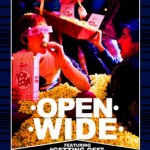Come Back to the Five & Dime, Jimmy Dean, Jimmy Dean by Ed Graczyk, a Woman Seeking…production @ Richard Hugo House. Directed by Christine Mosere. With Kate Szyperski, Eleanor Moseley, Sonia Perez and Laura Kenny. Now through March 14th. Visit the website for Tickets/Info/Directions.
It’s difficult to review a new production of an old play without commenting on the text of the play itself. It’s even more difficult when the production itself is fine; entertaining, provocative and well-acted, but the play never rises above an especially moronic episode of “Mama’s Family”. The primary reason this play is known at all is for its appeal for community theaters eager for shows with large female casts and its star-studded original production with Cher, Sandy Dennis and Karen Black and directed by Robert Altman. Altman and those actresses went on to reprise their roles in the film adaptation and while the film, (like the play) was never a commercial or critical success, it earned huge amounts of publicity due to the obvious star power of those involved. The fact that it had a catchy, easy to remember title probably didn’t hurt things either…would we remember this show at all, if it had been called “Reflections…” or “A Town Called McCarthy” or “Mona, Sissy and Joanne”? I think not.
The plot isn’t particularly difficult. It’s 1975 and we’re in McCarthy, Texas a small, west Texas town near Marfa, the sight of the 1955 filming of James Dean’s final film, Giant. Mona, a twitchy woman approaching middle age, is excitedly preparing for the 20th reunion of “The Disciples of James Dean” a local fan club founded by Mona after her participation in the filming of Giant as an extra “you can sort of see behind Elizabeth Taylor’s ear” in one scene of the film. The reunion (and the entire play itself) takes place in the town’s rundown Five and Dime store owned and operated by Juanita, an older, deeply religious woman who doesn’t quite approve of the fan club and Mona’s passionate love and devotion for the actor, James Dean. And for good reason; Mona claims that the child she had a few months after the filming of Giant ended was the result of a passionate night Mona shared with James Dean himself. As the play moves on, we quickly meet the rest of the fan club: Sissy the town tramp (with a heart of gold), and from out of town, the dim-witted, constantly pregnant Edna Louise and the trashy nouveau-riche, loud mouth Stella Mae. A fifth woman also mysteriously appears, an attractive woman driving a yellow Porsche, named Joanne and who she is and why she has turned up this drought stricken hellhole on this particular day forms the basis for the plot of “Jimmy Dean”.
But playwright Graczyk wasn’t happy with this simple of a plot, so he adds another layer onto the play. We also see events from 1955 and what led to the inception of the club and the conception of Mona’s lovechild “Jimmie Dean”. And, this is the start of the plays problems. The simultaneous playing of scenes, with one set of characters “frozen” while the other set of characters plays the scene is awkward and off-putting and difficult for directors to stage…it’s a filmatic device that has been clumsily grafted onto a theater piece. Like most cinematic devices adapted for the stage, it doesn’t successfully translate and hurts the intent of the play. It ends up distracting and not enhancing the work.
What does enhance the work are the actors, and though they aren’t anything more than stock stereotypes, the characters themselves. Hammy old southern corn pone characters might be cliche, but let’s be honest: even in dreck they tend to be very entertaining. People enjoy larger than life Southerners with their broad accents, vibrant personalities and emotional outbursts. And plays of the “Southern Gothic” genre, dedicated to revelations of long simmering secrets, lies, betrayals, seductions and other assorted closeted skeletons have long been a staple of the theater (Steel Magnolias, Crimes of the Heart, Tracy Letts’ Tony/Pulitzer Prize winning August: Osage County). In terms of quality, Jimmy Dean never rises to their ranks but the humor and the passion of the characters rescues the play from oblivion. You do find yourselves invested in the lives of these women, charactertures though they may be and I’ll grudgingly give some credit to the author for creating them, but I think it’s more likely the actors that inhabit these roles are largely the ones to be credited. And Woman Seeking…the new theatre group staging this production has the good fortune to be given an Equity waiver in order to cast some very talented local professional actresses in this show. They are the glue that bind this show together. And at the center of the story, Kate Szyperski has the difficult job of making the main character, Mona both believable and sympathetic despite the unbelievable and unsympathetic actions of the character. Mona is a self-centered, self-deluded hypochondriac who has lied to everyone in her life, treated her child like he was mentally deficient when he was not, and whose actions have lead to life changing consequences for the other people living in her orbit. On paper, Mona is a bit reprehensible but Ms Szyperski is able to flesh out the character and her motivations and enables us to ultimately feel empathy for Mona’s pain and lot in life. Equally good and surprisingly good casting for physically matching Szyperski is actress Alyssa Kay as the 1955 version of Mona. Her delicate performance nicely bookends the work of the older actress; it’s a believable transition from the hopes of the young, idealistic Mona to the crumbling realities facing the older version.
Another equally delightful pairing is that of the two actresses playing Sissy, the sassy town tramp beloved equally for her big mouth and even bigger bosom. Eleanor Mosely as the older Sissy is physically all wrong for the part; she is blessed with the long graceful lines of a well-bred racehorse suitable for tough noirish dames and elegant uptown/county club ladies, not small-town, white trash sluts, but Mosely’s talents as an actress quickly convinces you that she is Sissy and her strong abilities to play both the very obvious comedic aspects of the part as well as the truly tragic make Sissy the most interesting, entertaining and heart-breaking in the play. Rebecca Olson’s 17 year old version of the character doesn’t have the heartbreak to play in her scenes but Ms Olson has the comedic timing and sass of a young Rosalind Russell and you look forward to every one of her entrances; I’m guessing she’ll be getting her Equity card in very short order and will be using it for a long time to come.
The third major character in the play is Joanne and since this play is nearly 30 years old I think it’s safe to say, without fear of being labeled a “spoiler”, that Joanne is a transgendered character. Joanne was successfully portrayed by Karen Black in the original production and film and the odd charms of that charismatic actress were a good fit for the role but I don’t think Sonia Perez is the ideal casting for this role in this production. The beauty and the lush ripeness and femininity of Ms Perez doesn’t really mesh with the character of Joanne and what we know of her past; I’m not saying that transgendered woman cannot BE beautiful and feminine and curvy (many of them are!) but I don’t think that’s the direction that this character would have physically taken and certainly doesn’t match up with what we know of her life before gender reassignment. I think it’s also interesting to note that Ms Perez, judging by the short bio in the program, seems to be an actress more at home in musicals than straight plays; she seems a little out of her element in this production, which should work to her advantage considering the “outsider” nature of the role but instead only distances herself from the audience. We should love Joanne as much as we love the other characters by the end of the show, but I didn’t and I’m going to blame the casting and not the actress. Ms Perez is far too interesting and vibrant of an actress to be wasted in roles where she might not be suited and I would like to see her in roles more appropriate for her charms and talents, (I think she would make a splendid Dulcinea in Man of LaMancha, fiery yet poignant!)
The other two fan club members, the bovine Edna Louise and the loudmouth Stella Mae really don’t have much to do other than respond to the revelations of the other characters which sadly means that two excellent actresses are deprived of more to do. Laurie Bialik is sweetly moving as the dim but lovable and eternally pregnant Edna and the fiery little firecracker Susan Connors makes her few bits of business as Stella Mae stand out from the rest of the ensemble; you wish she had a larger part, or maybe a play all to her own. The same holds true for the sixth main character, Juanita, the older owner of the 5 and Dime. Juanita is an opinionated, God-fearing, small town Texas matron and she is one of the ripest characters in the show and she is played by one of the ripest character actresses in Seattle, the legendary Laura Kenny. If you only attend the theater once or twice a year, chances are you’ve run across Ms Kenny and her commandingly rich voice and peerless comic timing. Every theater town has a Laura Kenny (and Seattle luckily has more than one); dynamic, old-school actors who know how to use every tool in their body and every trick in the book to wring every ounce of entertainment value out of a theatrical text. Ms Kenny’s performance as Juanita was by far the most crowd pleasing and she deserved every bit of the ovation she received, but I am going to give her one critical note and that is to remind her she is playing in a small, black box theatre space and not a cavernously large, built for purpose theatre like the ones she is used to playing in at Intiman, and A.C.T. and the 5th Avenue and the Paramount, and she needs to compensate by lowering her volume control from the number ten setting she is used to playing at, to a more comfortable for a smaller space, five or six setting. I’m doubting that anyone, ever, had to tell Ms Kenny to “Sing out, Louise!” in her entire career as an actress…
FINALLY, (yes, this review is far too long), a shout out to director Christine Mosere for a difficult job well-done and to the entire staff and crew for coping with the obvious limitations of budget. Woman Seeking…is a small, new, under-funded theater company and this is only its second production. I’m hoping they can continue to flourish and grow and provide us with future productions of interest. And, do I recommend seeing this play? Yeah, actually I do. I still think the text is of dubious quality but the richness of the characters and the performances manages to overcome the turgidness of the text. The show is never boring, and individual moments make-up for the lack of dramatic integrity. It can also be very funny. Check it out now through March 14th at Richard Hugo House on Capitol Hill
-Michael Strangeways















